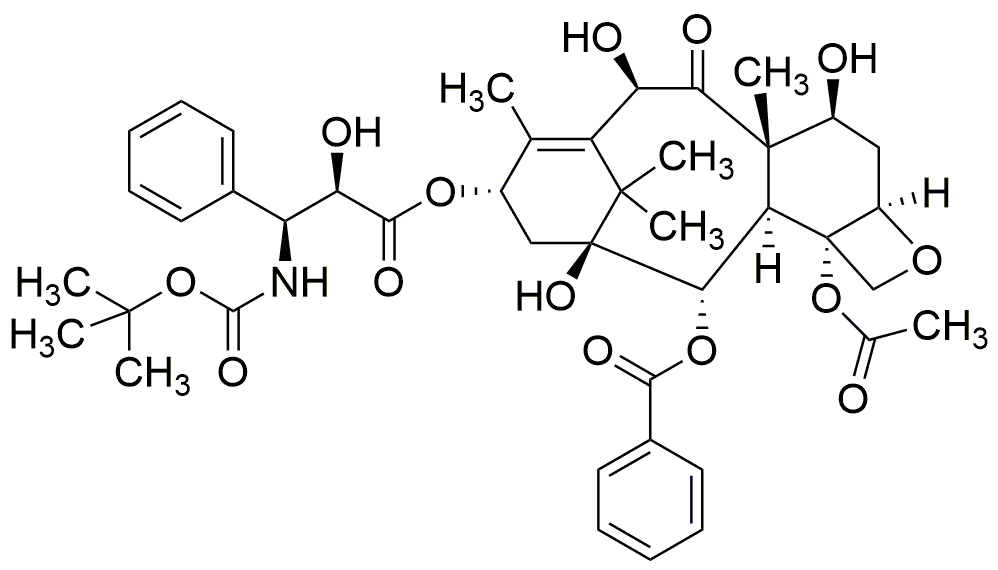Docetaxel is widely utilized in research focused on:
- Cancer Treatment: Primarily used as a chemotherapy drug for treating various types of cancer, including breast, lung, and prostate cancer. Its effectiveness in disrupting cancer cell division makes it a cornerstone in oncological therapies.
- Combination Therapies: Often combined with other medications to enhance treatment efficacy. For example, it can be paired with corticosteroids to reduce side effects and improve patient outcomes.
- Pharmaceutical Research: Used in the development of new formulations and drug delivery systems, allowing researchers to explore innovative ways to improve drug absorption and reduce toxicity.
- Clinical Trials: Frequently involved in clinical studies aimed at assessing new treatment regimens or combinations, providing valuable data that can lead to improved cancer therapies.
- Biotechnology Applications: Employed in the production of biosimilars, which are biologic medical products highly similar to already approved reference products, helping to expand treatment options for patients.
General Information
Properties
Safety and Regulations
Applications
Docetaxel is widely utilized in research focused on:
- Cancer Treatment: Primarily used as a chemotherapy drug for treating various types of cancer, including breast, lung, and prostate cancer. Its effectiveness in disrupting cancer cell division makes it a cornerstone in oncological therapies.
- Combination Therapies: Often combined with other medications to enhance treatment efficacy. For example, it can be paired with corticosteroids to reduce side effects and improve patient outcomes.
- Pharmaceutical Research: Used in the development of new formulations and drug delivery systems, allowing researchers to explore innovative ways to improve drug absorption and reduce toxicity.
- Clinical Trials: Frequently involved in clinical studies aimed at assessing new treatment regimens or combinations, providing valuable data that can lead to improved cancer therapies.
- Biotechnology Applications: Employed in the production of biosimilars, which are biologic medical products highly similar to already approved reference products, helping to expand treatment options for patients.
Documents
Safety Data Sheets (SDS)
The SDS provides comprehensive safety information on handling, storage, and disposal of the product.
Product Specification (PS)
The PS provides a comprehensive breakdown of the product’s properties, including chemical composition, physical state, purity, and storage requirements. It also details acceptable quality ranges and the product's intended applications.
Certificates of Analysis (COA)
Search for Certificates of Analysis (COA) by entering the products Lot Number. Lot and Batch Numbers can be found on a product’s label following the words ‘Lot’ or ‘Batch’.
Numéro de catalogue
Numéro de lot/série
Certificates Of Origin (COO)
This COO confirms the country where the product was manufactured, and also details the materials and components used in it and whether it is derived from natural, synthetic, or other specific sources. This certificate may be required for customs, trade, and regulatory compliance.
Numéro de catalogue
Numéro de lot/série
Safety Data Sheets (SDS)
The SDS provides comprehensive safety information on handling, storage, and disposal of the product.
DownloadProduct Specification (PS)
The PS provides a comprehensive breakdown of the product’s properties, including chemical composition, physical state, purity, and storage requirements. It also details acceptable quality ranges and the product's intended applications.
DownloadCertificates of Analysis (COA)
Search for Certificates of Analysis (COA) by entering the products Lot Number. Lot and Batch Numbers can be found on a product’s label following the words ‘Lot’ or ‘Batch’.
Numéro de catalogue
Numéro de lot/série
Certificates Of Origin (COO)
This COO confirms the country where the product was manufactured, and also details the materials and components used in it and whether it is derived from natural, synthetic, or other specific sources. This certificate may be required for customs, trade, and regulatory compliance.


